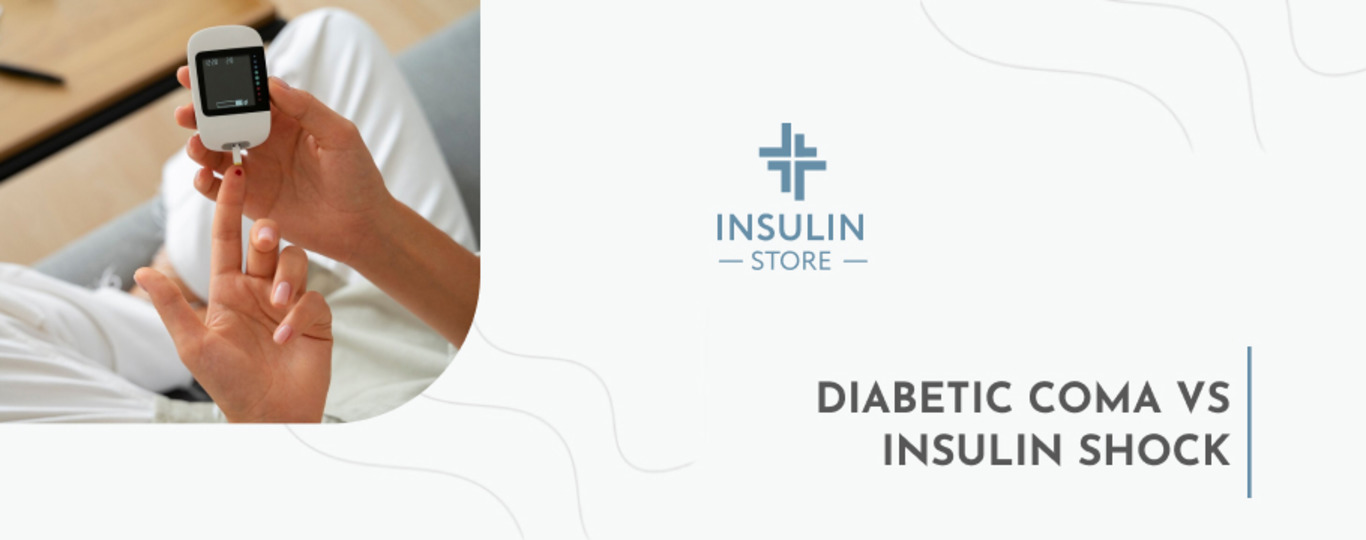
Diabetes Complications: Diabetic Coma vs. Insulin Shock
Living with diabetes requires consistent monitoring of blood glucose levels. A peson should know how to prevent complications such as diabetic coma or insulin shock. These life-threatening conditions need immediate medical emergency help. Being aware of the high or low blood sugar symptoms and risk factors is can save the lives of diabetics.
In this blog post, we will explore the causes, symptoms, and consequences of diabetic coma and insulin shock. Let’s empower you with vital guidelines.
A kind reminder: Our website contains a wide range of diabetic medications at affordable prices. Don’t hesitate to buy Canadian insulin here. Just obtain a valid prescription from your doctor.
Diabetes Overview
Diabetes is a chronic metabolic disorder characterized by high blood glucose (sugar) levels. This condition occurs when the body doesn’t produce enough insulin, a hormone that regulates blood sugar, or doesn’t effectively use the insulin it makes. Insulin Autoimmune Syndrome, though rare, is another condition where the body produces antibodies that attack its own insulin, leading to fluctuating blood sugar levels. Diabetes care requires ongoing management to control the blood sugar level and prevent complications. Treatment typically involves a combination of medication, lifestyle modification, a regular meal, diet and exercise, and blood glucose level monitoring.
Risk of High or Low Blood Sugar Levels
Both high blood sugar (hyperglycemia) and severe low blood sugar (hypoglycemia) can provoke serious complications and require immediate medical attention.
Uncontrolled high blood sugar rate might not cause immediate symptoms, its effects accumulate over time. This potentially can damage nerves, blood vessels, and organs throughout the body. Additionally, it may increase the risk of heart disease, stroke, kidney disease, eye problems, and nerve damage.
Severe hypoglycemia, also known as diabetic shock, requires immediate medical attention and appropriate treatment. Consequences of delay may result in diabetic coma, brain damage and even death.
Diabetic Coma vs. Insulin Shock: General Information
A diabetic coma is a severe and life-threatening complication of diabetes. It occurs when blood glucose levels become dangerously high, leading to an unconscious person state. This condition typically develops gradually over time, often due to untreated or poorly managed diabetes.
Insulin shock, or hypoglycemia, is a critical condition that arises when the sugar drops to dangerously low blood sugar levels, typically below 70 mg/dL. The diabetic shock happens when there is an excess insulin in the bloodstream relative to the amount of glucose available for energy.
Reasons for Diabetic Coma
Each type of diabetic coma has its causes. Understanding them is vital for patients with diabetes and their caregivers to prevent triggers and recognize warning signs promptly. Let’s explore type by type.
#1. Diabetic ketoacidosis (DKA)
This type of diabetic coma is primarily caused by insufficient insulin levels, leading to high blood sugar levels and the accumulation of ketones in the blood.
Key reasons:
- not enough insulin: when the body doesn’t receive enough insulin, glucose cannot enter cells for energy, leading to elevated sugar levels and the breakdown of fat for fuel, producing ketones.
- insulin delivery problems: malfunctions with insulin pumps or missed insulin doses can contribute to insufficient insulin, exacerbating the risk of DKA.
- missed meals: it can lead to low blood sugar levels, causing the body to break down fat for energy.
- illness or infection: this issue can increase stress hormones, raise blood sugar levels, and increase the body’s need for insulin.
#2. Hyperosmolar hyperglycemic state (HHS)
HHS is another life-threatening complication arising from extremely high blood sugar levels (hyperglycemia) and severe dehydration. Unlike DKA, HHS typically doesn’t involve significant ketone production.
Key reasons:
- uncontrolled diabetes: people with undiagnosed or poorly managed diabetes are at a higher risk of HHS.
- insulin resistance: the body with type 2 diabetes may resist the effects of insulin, causing blood sugar levels to rise.
- severe dehydration: this condition is often caused by illness, vomiting, diarrhea, or excessive urination due to a high blood sugar level.
- certain medications: for example, diuretics can contribute to dehydration and worsen HHS.
- medical conditions that impair kidney function or increase the risk of dehydration.
#3. Hypoglycemia-induced coma
A coma induced by hypoglycemia is typically the result of severe low blood sugar levels. The brain relies heavily on glucose for energy, and when levels drop dramatically, it can’t function properly, leading to coma.
Key reasons:
- too much insulin or using the wrong type can cause a blood sugar level to drop too low.
- missed meals or delayed meals can provoke hypoglycemia or diabetic shock.
- alcohol consumption: drinking alcohol without adequate food intake can lead to low blood sugar levels.
- increased physical activity increases muscle glucose, potentially lowering blood sugar levels.
Diabetics can take proactive steps to prevent causes of diabetic coma. Early detection and treatment are critical for a positive outcome.
Diabetic Coma Symptoms and Risks
Different types of diabetic coma have distinct causes. Consequently, their symptoms can also vary. Here’s a breakdown of the warning signs to watch for:
Diabetic ketoacidosis (DKA):
- high blood sugar;
- frequent urination;
- extreme thirst;
- fruity-smelling breath and urine;
- nausea and vomiting;
- abdominal pain;
- shortness of breath;
- confusion and drowsiness.
Is falling asleep after eating a sign of diabetes? While it’s not a definitive symptom, unexplained fatigue, especially after meals, could indicate blood sugar fluctuations, which are common in diabetes and could lead to more serious complications if left unchecked.
Hyperosmolar hyperglycemic state (HHS):
- frequent urination;
- extreme thirst and dry mouth;
- extreme fatigue and weakness;
- confusion and disorientation;
- seizures;
- fever;
- blurred vision.
Hypoglycemia-induced coma:
- shaking;
- excessive sweating;
- hunger symptoms;
- paleness;
- anxiety;
- lightheadedness or dizziness;
- difficulty concentrating;
- seizures;
- slurred speech.
If you or someone with diabetes experience these severe symptoms of hypoglycemia, don’t hesitate to call your local emergency number or seek immediate medical attention.
Remember, even mild hypoglycemia with typical symptoms like fatigue and irritability shouldn’t be ignored. Consistent monitoring can prevent diabetic coma symptoms and serious complications.
Risks of Diabetic Coma
Left untreated, any type of diabetic coma can lead to severe complications. The most concerning risk is permanent brain damage. When the brain is starved of sugar for extended periods, it can suffer lasting consequences. At the first stage, a person can lose consciousness. In severe cases, diabetic coma can lead to the risk of heart attack, stroke, kidney failure, mental changes, or even death.
When blood sugar level drops too low, it can lead to severe hypoglycemia, also known as insulin shock.
Causes of Insulin Shock
Severe low blood sugar level is the main cause of insulin shock. This sudden drop in blood glucose disrupts the body’s ability to function properly, as the brain relies heavily on glucose for energy. Here are the primary causes of insulin shock:
- disproportionate insulin administration due to miscalculation or changes in insulin needs.
- skipping or delaying meals.
- strenuous physical activity.
- consuming alcohol without eating enough food.
- mechanical failures or user errors with insulin delivery devices.
- medication interactions.
- changes in insulin sensitivity.
- consuming a low-carb diet.
- hormonal changes like menstruation or pregnancy.
Important note: everyone’s body reacts differently to these factors. What might cause insulin shock in one person might not have the same effect on another.
Insulin Shock Symptoms and Risks
The symptoms of insulin shock can appear quickly and worsen rapidly if left uncured.
- Early signs are sweating, shaking, anxiety, paleness, dizziness, and difficulty concentrating.
- Moderate symptoms may include confusion, rapid heartbeat, and blurred vision.
- Severe symptoms may involve seizures, unconsciousness, diabetic coma, and mental changes.
Frequent episodes of insulin shock can lead to hypoglycemia unawareness, where the individual no longer recognizes early warning signs. If this state is left untreated, it can lead to diabetic coma with further complications like brain damage and death in severe patients.
How to Prevent Diabetic Coma vs. Insulin Shock
Both diabetic coma and insulin shock stem from imbalanced blood sugar levels. Thankfully, there are several strategies you can implement to minimize the risk of experiencing either condition.
- Regularly monitor your blood sugar level as it is the cornerstone of diabetes management. This allows you to identify trends and adjust your diet, medication, or exercise routine.
- Eat a balanced diet and stick to consistent meal schedules, regulating and supporting blood glucose levels. Consult healthcare providers or registered dietitian to create a personalized meal plan. Discuss with your doctor appropriate exercise routines.
- Take insulin or other diabetes medications exactly as prescribed by your doctor. Never adjust your dosage without consulting your healthcare provider.
Educate yourself and people around you about warning symptoms of high or low blood glucose rate, diabetic shock and coma. Wearing a medical alert bracelet that identifies you as diabetic can be lifesaving and enabling prompt treatment.
How to Avoid Taking Too Much Insulin
This is a serious medical emergency requiring prompt response. Here how you can minimize the risk of taking too much insulin:
- Always take insulin exactly as prescribed by your doctor.
- Never adjust dosage by your own, better consult your therapiest.
- Be mindful of factors that may influence your blood sugar levels.
- Monitor blood glucose regularly.
- Discuss nay concerns and questions with your healthcare providers.
The Fist Aid for Insulin Shock and Pre-Coma Conditions
If you suspect someone, including yourself, is experiencing insulin shock or a state that is close to diabetic coma:
- Call your local emergency personnel immediately – don’t wait for symptoms to worsen;
- If the person is consious and able to sallow, offer the first aid such as glucose tablets or orange juice to raise their blood sugar levels quickly;
- A glucagon injection may be necessary. If person has medical alert braclet indicating diabetes, they might carry one.
Early diagnosis and treatment of these severe conditions are critical to minimize the risk of complications. Acting swiftly and seeking medical care for diabetic shock or other symptoms, you can significantly improve the chance of full recovery.
Final Thoughts
Being a person with diabetes requires vigilance with management and proactive approach. These actions can reduce the risk of complications like diabetic coma or insulin shock. Remember, consistent blood sugar monitoring, healthy lifestyle choices, and open communication with your doctor are key to achieving optimal diabetes control and living a fulfilling life.
